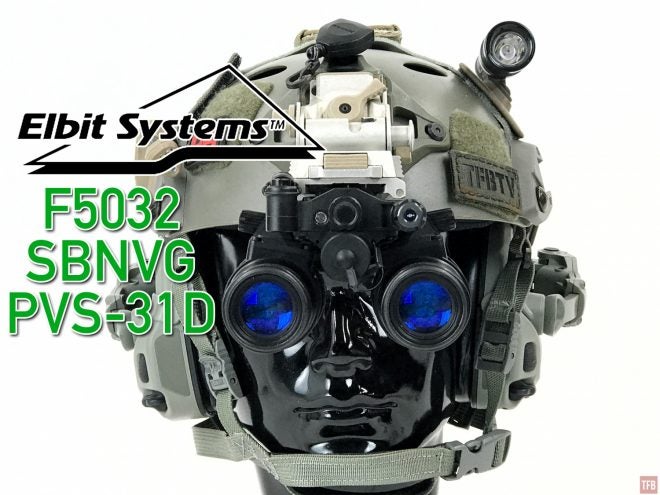This Friday Night Lights we will continue the Dual Tube Spotlight mini-series where we take a look at binocular night vision goggles. This week we have the Elbit Systems of America F5032. It is also known as the SBNVG and PVS-31D. The Friday Night Lights series is brought to you by ATN Corp, manufacturers of night vision and thermal optics like the THOR LT. As with all of our sponsored series, Friday Night Lights will continue to bring you unbiased news and reviews from a variety of companies.
Dual Tubes @TFB:
- Friday Night Lights: Dual Tube Spotlight – ABNV MOD-3
- Friday Night Lights: Dual Tube Spotlight – DTNVG (Dual Tube Night Vision Goggle)
- Friday Night Lights: Dual Tube Spotlight – BNVD-SG
- Friday Night Lights: Dual Tube Spotlight – BNVD-1531s & DTNVS
Elbit F5032 Or Theon Sensors NYX?
The Elbit F5032 appears to be just a Theon Sensors housing with Elbit tubes inside. I am not sure what glass they are using but they are proprietary. They are not using PVS-14 optics. It is possible Elbit has US mil-spec glass made for their versions of the F5032. But the goggle is still a Greek housing. Here is a link to Theon Sensor’s website. They do not have a lot of photos on their website but here they are below. I edited them in photoshop to eliminate the fake nighttime filter they used so you can see the goggle better.
Edit: According to Pavlos Saltas of Theon Sensors, they provide the SKD kit to Elbit US. Which is a complete housing with optics but no tubes. The equivalent to the 5032 is called the NYX which is sold and used around the world.

Photo by Theon Sensors

Photo by Theon Sensors

Photo by Theon Sensors

Photo by Theon Sensors
F5032, SBNVG or PVS-31D? Which Is It?
Back in 2019, Elbit won a $249 million dollar contract with the US Marines to provide them with the SBNVG (Squad Binocular Night Vision Goggle). That nomenclature is specific for the Marines. Here is a screencap from Elbit Systems of America’s website.
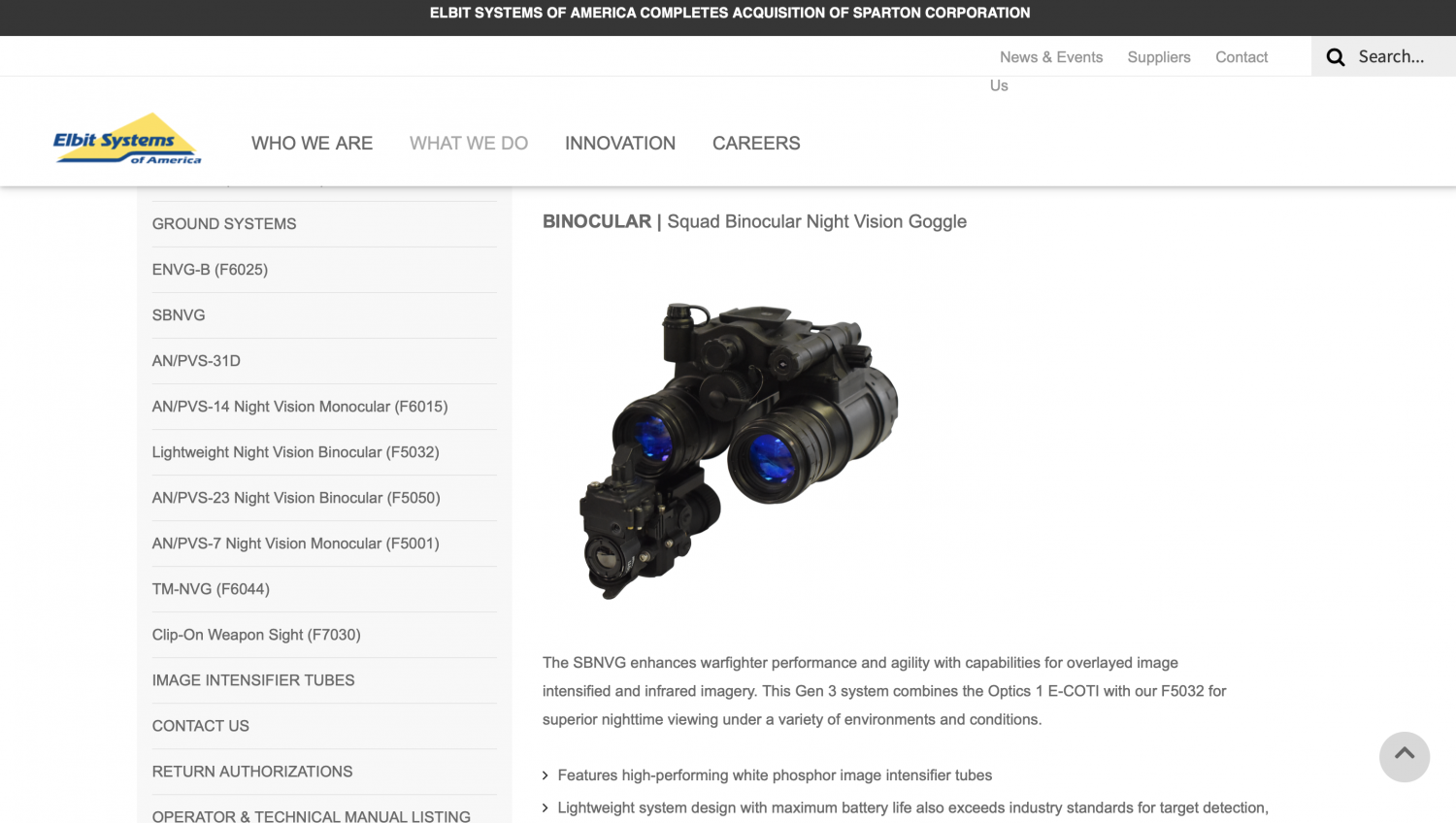
Screencap from Elbit Systems website.
The SBNVG enhances warfighter performance and agility with capabilities for overlayed image
intensified and infrared imagery. This Gen 3 system combines the Optics 1 E-COTI with our F5032 for
superior nighttime viewing under a variety of environments and conditions.
- Features high-performing white phosphor image intensifier tubes
- Lightweight system design with maximum battery life also exceeds industry standards for target detection, thermal highlighting, focus range and mechanical backlash
- Intra-Soldier Wireless (ISW) capability for networked growth capability to include remote sensors such as range finders and additional video feeds to be presented to the warfighter
- Integrated compass provides heading information and forward projecting near infrared (NIR) illuminator enables subterranean (SubT) operations. These combined features maximize stand-off protection and increase situational awareness
The Elbit Systems binocular night vision goggle is actually called the F5032 but they choose to call it the PVS-31D on their website.
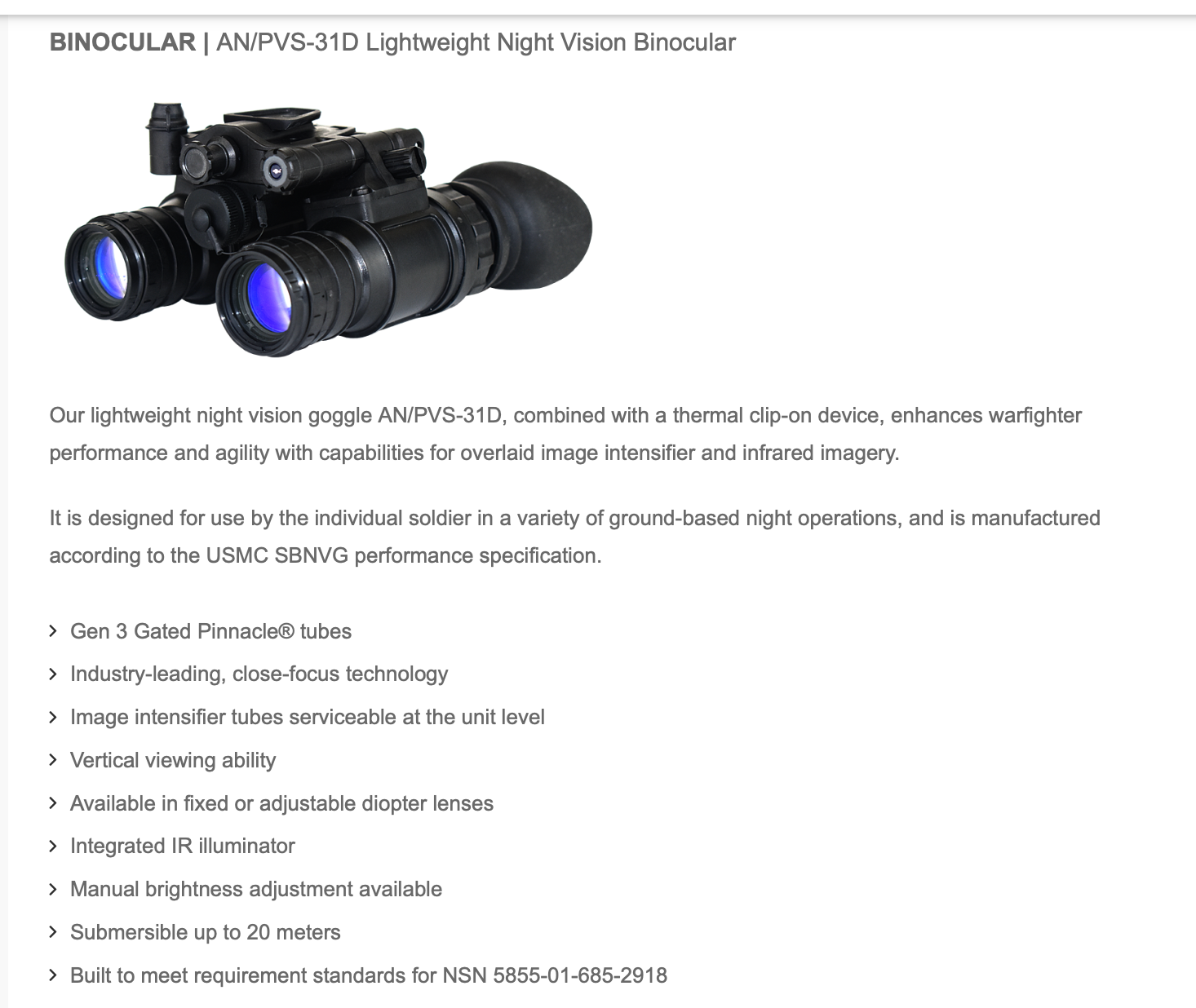
Screencap from Elbit Systems website.
Our lightweight night vision goggle AN/PVS-31D, combined with a thermal clip-on device, enhances warfighter performance and agility with capabilities for overlaid image intensifier and infrared imagery.
It is designed for use by the individual soldier in a variety of ground-based night operations, and is manufactured according to the USMC SBNVG performance specification.
- Gen 3 Gated Pinnacle® tubes
- Industry-leading, close-focus technology
- Image intensifier tubes serviceable at the unit level
- Vertical viewing ability
- Available in fixed or adjustable diopter lenses
- Integrated IR illuminator
- Manual brightness adjustment available
- Submersible up to 20 meters
- Built to meet requirement standards for NSN 5855-01-685-2918
Here is the F5032 that is listed on their website.

Screencap from Elbit Systems website.
The various nomenclature is a bit confusing. Especially when someone uses “PVS-31” to refer to the Elbit F5032/SBNVG. There are other binocular night vision goggles that use that designation. The L3/Harris BNVD is called the AN/PVS-31A. You also have a Canadian binocular goggle that they call PVS-31C. So it is important to get the designation correct when you are trying to talk about these different goggles. For the sake of being less confusing, we will just use F5032 to refer to the Elbit Systems dual tube goggles.
A Close Look At The F5032
Huge thanks to my friend Greg for lending me his goggles so I could document them. There is not much that is revolutionary about the F5032. They are an articulating goggle that has all the same accouterment that you expect to find in a dual tube bino. I have a feeling the F5032 was designed to meet certain military requirements.




The F5032 monocular pods can flip away and up. They have a magnetic reed switch that shuts power to the pods just like DTNVG/DTNVS.


Like any articulating goggle, the pods folding back and closer to the helmet is great for long-term use in the stowed position.

It does not seem like much of a difference but rolling the pods back closer to the helmet feels a lot better. Also, this helps reduce the chances of you hitting your night vision on things.






Here is why the nomenclature and designation of these binocular night vision goggles is convoluted. It says F5032 on the housing and yet these are considered to be the PVS-31D as well as the SBNVG.

Similar to the L3/Harris BNVD PVS-31A, the F5032 has a remote battery port. But unlike the PVS-31A, this port is oriented vertically. This is a better solution than the PVS-31A design since the Fischer plug, for the L3 goggle, sticks out the side and interferes with the complete range of the right pod.

Below is a screenshot from a video interview with Elbit Systems about the SBNVG. You can see the remote battery pack cable plugged into the F5032.
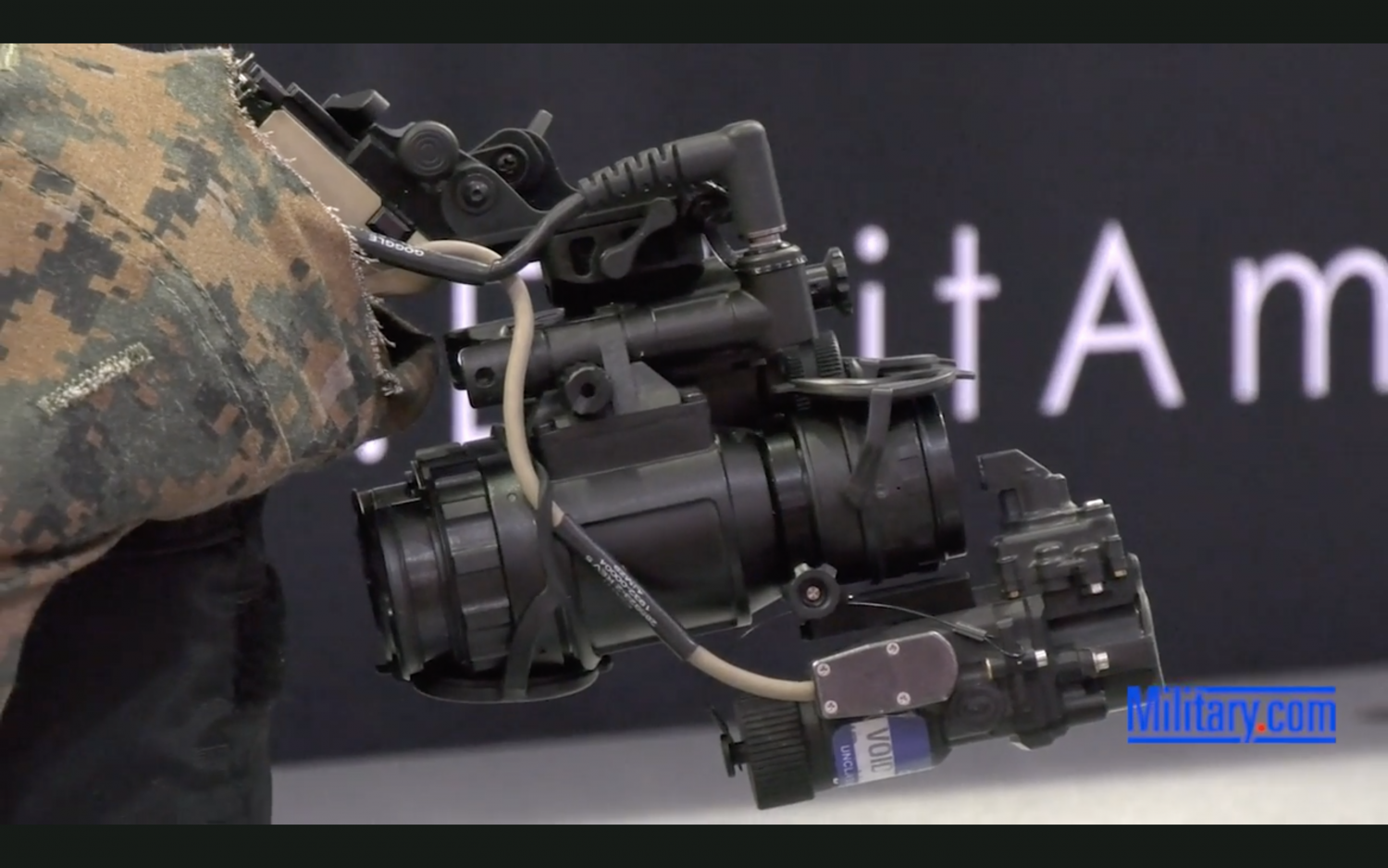
Screencap from Military.com
The F5032 has pupillary distance stops similar to the BNVD-1431 and PVS-31A. It is a screw on either side of the goggle.

Tightening the screw moves this stop inwards thus making the distance between eyepieces wider. Loosen the screw to allow the pods to move closer together.


Like the L3/Harris BNVD, the F5032 is powered by a single AA battery for 30 hours. Or you can get the remote battery pack for a longer run time. I like the coarse threads on the battery compartment – less time tightening or untightening the battery cap to change batteries. Also, it is virtually impossible to cross-thread this.
The bridge has an integrated infrared illuminator. You can see the power switch to the left of it and directly above the battery cap. You press this switch inwards to turn on the F5032. Double tapping the switch turns on the illuminator. Rotating the switch adjusts the manual gain. What I found peculiar is that the F5032 does not ramp the manual gain like a PVS-14 or PVS-31A. Instead, it changes gain in steps – 12 steps from full brightness to lowest brightness.

Greg’s F5032s came with bikini covers. I like how they are designed and attach to the optics. The front lens covers also double as pinhole day filters. They have pull tabs on either side.


The front lens covers are attached to the monocular pod just behind the objective lens. The cover has a lip on it that snaps into the inside track of the objective lens.

The rear eyepiece covers are similar to the objective lens covers. They have pull tabs and attach using a secondary ring that is slipped over the eyepiece.


When pulled down, the covers just sit under the lenses.

EnhanceD Clip-On Thermal Imager (ECOTI)
The US Marines SBNVG is not just the dual tube F5032. Elbit is bundling them with the E-COTI by Optics 1. I reviewed an E-COTI last January.
Here is the Jerry-C mounted to the F5032. The mounting clamp is designed for PVS-14 optics so the only way I could get this to work was to clamp the mount directly to the lens rather than the infinite focus stop behind it.


Final Thoughts On the F5032

Theon Sensors claims the Mikron-D is the “lightest NV binocular”. However that uses 16mm image intensifiers. The 5032 is not the same system and it weighs 18.8 ounces. That is 3 ounces more than the PVS-31A by L3/Harris. Using lightweight RPO lenses I was able to build a UANVB Katana that only weighed 15.4 ounces.
Elbit charges over $11,000 for the F5032. Greg got his on sale for under $10K and it came with Elbit white phosphor tubes. I do not know the specs of his tubes and while they looked good, I did not see them being better than my Elbit SLH tubes that have 2818 FOM. If you are lucky and can get hand-select tubes, you can save a bit of money and choose the housing of your preference. Unfortunately, the F5032 is a complete system, you cannot buy the goggle housing separately. Also, I am unable to find a price for the battery pack. While the F5032 is interesting because it is what the US Marines will be getting, I do not see it as a better option than what is commercially available for similar prices or less for similar or better performance.
TFB’s Friday Night Lights series is brought to you by ATN
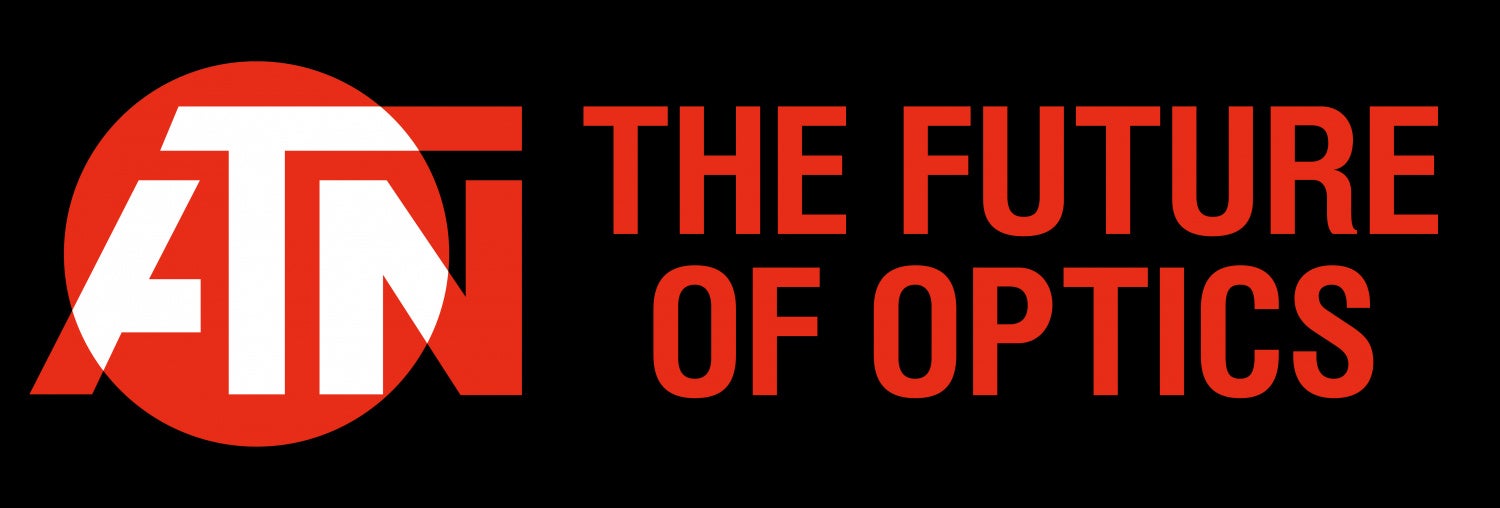
 Your Privacy Choices
Your Privacy Choices
